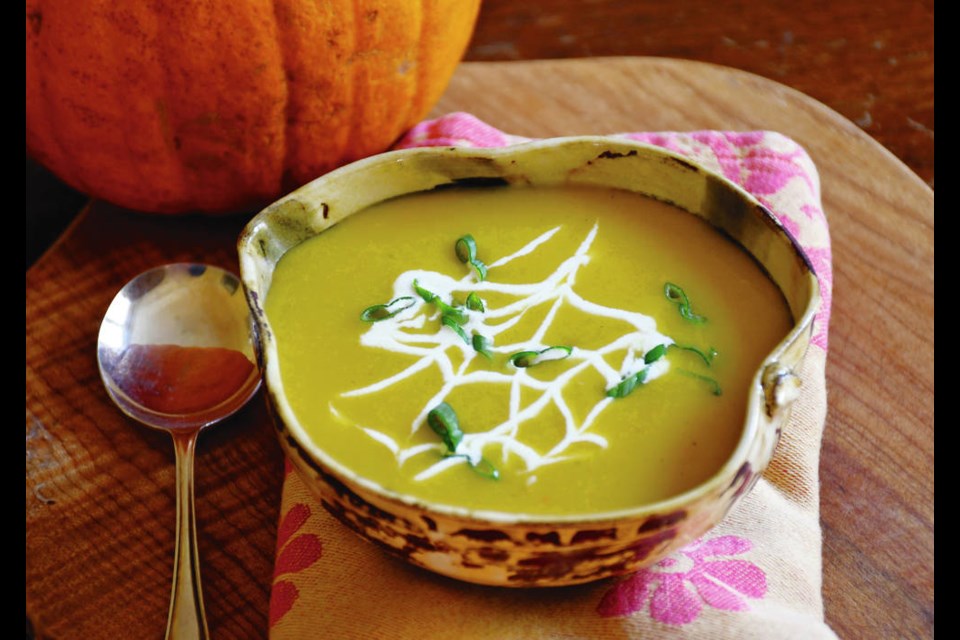Almost every fall since I began writing this column, I’ve offered recipes using canned pumpkin. On some occasions, readers have written to tell me that, despite the labelling, canned pumpkin is not pumpkin at all; it’s squash.
A reader, Derek, sent me an email to that effect after my . I told him I would write a column about the subject.
Let me start by saying it’s complicated. Why? Well, many culinary guides say pumpkins are members of the squash family. So, by that logic, canned pumpkin is squash.
For example, in Bert Greene’s book Greene on Greens, he says pumpkin, although botanically a summer squash, is available only in fall. And, since it’s very similar to winter squash, he labels pumpkin a pre-winter squash.
In Pete Luckett’s book The Green Grocer’s Kitchen, he says pumpkin is a generic name for any winter squash round in shape, usually ridged and bright orange.
The Oxford Companion to Food delves more deeply into this subject in a section on Cucurbits, plants with a vine-like habit of growth. Some Cucurbits have well-established common names, such as watermelon and cucumber. But within the family Cucurbitaceae, one genus, Cucurbita (Latin for gourd), which includes pumpkin and squash, common names tend to be loosely applied. One example is kabocha squash, also called Japanese pumpkin.
Groups of plants in the Cucurbita genus include C. pepo, C. maxima and C. moschata. C. pepo are summer squash varieties, which include zucchini and, as Greene noted, pumpkins.
Some sources suggest that “true” pumpkins can only come from C. pepo, which include the common field pumpkins carved for Halloween. But the latter is not the type used to make canned pumpkin. Dickinson pumpkins most often are.
Lore suggests Elijah Dickinson brought seeds for this type of pumpkin to Eureka, California, from Kentucky in 1835. Sixty or so years later, Elijah’s son Roger and his sons began operating a canning factory there.
Consumers liked their canned Dickinson pumpkin and, by 1925, they had opened two more factories. In 1929, the company was sold to the Libby, McNeil and Libby Cannery, which was purchased by Nestlé in 1970.
Oblong with flattened ribbing and tan/very pale orange-skin, Dickinson pumpkins have thick, orange, high-quality, sweet and flavourful flesh, qualities that mild-tasting, stringy-fleshed field pumpkins don’t have. For many, the taste of that canned pumpkin is strongly associated with Thanksgiving, especially when used in pumpkin pie.
Despite its long history, some say canned pumpkin is a grand deception because the Dickinson pumpkin is a member C. moschata, which has many varieties of winter squash in it, including the butternut, which it’s similar to. In other words, it’s not a pumpkin. It’s a squash.
On that point, in an article for the Atlantic, Rachel Gutman quotes Cindy Ott, author of Pumpkin: The Curious History of an American Icon. Ott said that until the 19th century, the words pumpkin and squash were used interchangeably. “It’s the same damn vegetable!” Ott said. “The difference is all about symbolism.”
Other sources, including the Oxford Companion to Food, not to mention many seed-company catalogues, note that other plants named pumpkin can, indeed, be found in C. moschata and C. maxima.
If you’re still leery about canned pumpkin and want to cook your own, you’ll find a variety of pumpkins, such as sugar (also called pie), Cinderella, Rouge Vif d’Etampes, Queensland blue and Galeux d’Eysines (also called peanut) pumpkins for sale at some Greater Victoria food stores and farm markets.
Curried Pumpkin and Pear Soup
Here’s a curry-powder-spiced, silky smooth soup featuring the earthy taste of fresh pumpkin and sweet pear. This soup, once cooled to room temperature, could be frozen.
Any type of fresh pumpkin should work in this soup.
Preparation time: 25 minutes
Cooking time: about 30 minutes
Makes: six servings
3 Tbsp vegetable oil
1 small onion, halved and sliced
2 Tbsp all-purpose flour
2 to 3 tsp mild or medium curry powder, or to taste
2 tsp chopped fresh ginger
3 3/4 cups chicken or vegetable stock
3 1/2 cups fresh pumpkin, peeled and cut into 1-inch cubes
2 ripe medium pears, peeled, cored and cubed
2 tsp honey
1 tsp finely grated lime zest
• juice from 1 lime
• salt and white pepper, to taste
• whipping cream, to taste (optional)
• thinly sliced green onion, to taste
Heat oil in a pot set over medium heat. Add onion and cook until tender, about five minutes. Mix in flour, curry powder and ginger, and cook and stir two minutes.
While stirring, slowly pour in one cup of stock. When mixture is thick, mix in the remaining stock.
Add pumpkin, pear, honey, zest and juice to the pot and bring soup to a gentle simmer. Simmer soup, uncovered, until pumpkin is very tender, about 20 minutes.
Purée soup in a food processor or blender, or in the pot with a hand (immersion) blender, then season with salt and pepper.
To serve, ladle soup into bowls, drizzle with a little cream, if using, sprinkle with green onion and enjoy.
Eric Akis is the author of eight cookbooks. His columns appear in the Life section Wednesday and Sunday.



